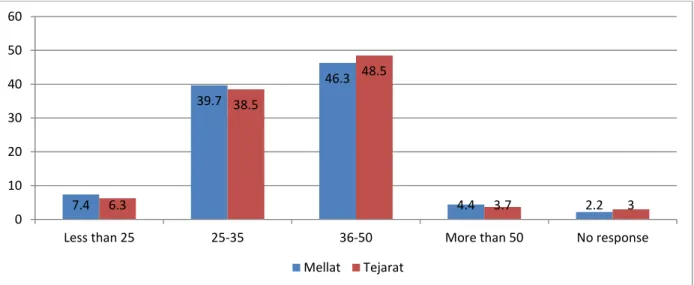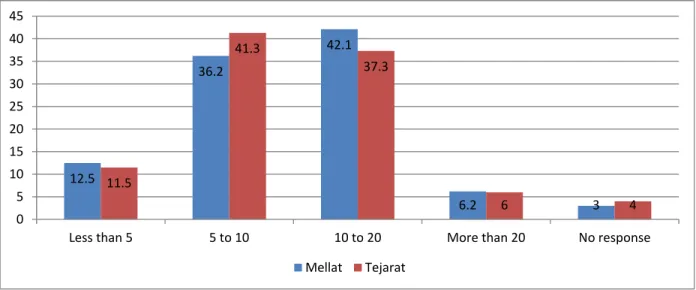*Corresponding author. Tel: +98-912-3571103 E-mail addresses: m-ansar@hotmail.com (M. Ansar)
© 2013 Growing Science Ltd. All rights reserved. doi: 10.5267/j.msl.2013.05.031
Contents lists available at GrowingScience
Management Science Letters
homepage: www.GrowingScience.com/msl
How customer satisfaction changes behavior: A case study of banking industry
Hossein Vazifedoosta*, Mahmood Ansarb and Amir Yekezarec
a
Associate Prof, Department of Financial Management, Science and Research branch, Islamic Azad University (IAU), Tehran, Iran b
Ph.D. Student, Department of Financial Management, Science and Research branch, Islamic Azad University (IAU), Tehran, Iran
C H R O N I C L E A B S T R A C T
Article history:
Received January 25, 2013 Received in revised format 17 May 2013
Accepted May 18 2013 Available online May 20 2013
An increase on competition industry from one side and the need for customer retention on the other side in banking industry create necessary motivation to learn more about customer behavior. This paper investigated the relationship between seven perspectives of banking services and customers’ attitude towards changing behavior. The seven perspectives included how bank employees’ treat customers, service prices, how to promote and market synergies, place and time to serve customers, products, equipment and process. The proposed study was implemented in two Iranian banks called Mellat and Tejarat in city of Tehran, Iran. The results indicated that all components except one case, which was “how to promote and market synergies” had meaningful and negative relationship with customer behavior.
© 2013 Growing Science Ltd. All rights reserved.
Keywords:
Customer behavior Customer satisfaction Customer retention
1. Introduction
some 7 percent of respondents said they had spoken to bank staff in the period before exiting. Furrer et al. (2000) argued that perceptions of service quality vary across cultural groups, as described by each culture’s position on Hofstede’s dimensions. They implemented the correlation coefficients to compute a Cultural Service Quality Index, which could be implemented to segment international service markets. Garland (2002) examined a sample of 881 customers’ self-reported to estimate the likelihood of defection from some main bank based on Juster probability scale.
According to Holmlund and Kock (1996), relationship marketing has recently been introduced within services marketing. The reason is because more efficient, profitable and long-term marketing can be achieved by concentrating on present customers instead of concentrating on attracting new ones. Retail banks have had a unique position as they have a well-developed system of local offices that help them be close to their customers. The service quality as perceived by the customers must at least reach customers’ expectations. Otherwise, there is a possibility that a dissatisfied customer could start looking for another bank giving similar services, resulting in a break in the relationship with the bank.
Rust and Zahorik (1993) provided a mathematical framework for evaluating the value of customer satisfaction. The framework enabled managers to detect which customer satisfaction elements had the biggest impact, and how much money should be invested to improve specific customer satisfaction elements. This helps us hold customer satisfaction programs accountable, in the way that other business programs would be held accountable, by forcing them to demonstrate their benefits with respect to bottom-line profitability. They implemented an individual-level model of loyalty and retention, and then built up to market share by aggregation.
According Lees et al. (2007), losing customers to another bank have worried bank executives. Detecting the reasons why customers switch banks helps many executives plan their customer retention including customer recovery and customer acquisition strategies. Lees et al. (2007) gave some insights of switching by applying a categorization of switching behavior detected in repertoire markets to subscription markets. This helps us forecast about the content of customers' post-switch brand repertoires, or consideration sets. They showed that construction of customers' post-switch consideration sets was antecedent specific, and concluded that while the previous main bank brand may have been forsaken, it is not forgotten.
Zhou (2004) examined specific perspectives of the performance-only measurement of service quality (SERVPERF) as determinants of consumer satisfaction and subsequent behavioral intentions related to banking services in mainland China. They stated that their results could enhance the validity of the performance-only approach to service quality through the concentration on the multidimensional facets of the SERVPERF scale.
Danaei et al. (2013) studied the impact of advertisements on customers’ willingness to accept banking services based on modulatory role of brand. They reported that there was a positive and meaningful relationship between brand advertisement and associate name and brand identification. However, there was no meaningful relationship between brand advertisement and customer loyalty towards to brand. Besides, the results of survey indicated there was a meaningful relationship between brand equity components including perception quality on brand name, customer awareness from brand, loyalty to brand and customers’ willingness to accept banking services on modulatory role of brand.
H. Vazifedoost et al. / Management Science Letters 3 (2013)
1589
2. The proposed study
The proposed study of this paper designs a questionnaire and distributes it among a sample of 384 bank customers who regularly visit this bank. The sample size was calculated based on Krejcie-Morgan Table and the questionnaire was validated based on Cronbach alpha, which was calculated as 0.883. The main hypothesis of this survey is as follows,
Main hypothesis: There is a meaningful relationship between customer satisfaction in terms of seven perspectives and change in customer’s behavior.
There are also seven sub-hypotheses associated with the proposed study of this paper as follows,
1. There is a meaningful relationship between customer satisfaction from bank’s employees and
change in customer behavior.
2. There is a meaningful relationship between customer satisfaction from bank’s service prices
and change in customer behavior.
3. There is a meaningful relationship between customer satisfaction from bank’s place and time
and change in customer behavior.
4. There is a meaningful relationship between customer satisfaction on how bank promotes and
markets synergies and change in customer behavior.
5. There is a meaningful relationship between customer satisfaction from bank equipment and
change in customer behavior.
6. There is a meaningful relationship between customer satisfaction from bank price and services
in customer behavior.
7. There is a meaningful relationship between customer satisfaction from bank services and
change in customer behavior.
2.1. Characteristics of the participants
In our survey for Bank Mellat, 95 people representing 23.4% of the participants were female, 303 people representing 74.6% of them were male and the remaining people did not answer this question, properly. In addition, 16 people representing 15.7% of the customers who used the services of Bank Tejarat were female while 331 people representing 82.8% of the participants were male and 1.5% of them did not respond to gender question. Overall, 84% of the participants were male. Fig. 1 shows details of participants’ personal characteristics in terms of age,
Fig. 1. Frequency of participants’ age
7.4
39.7
46.3
4.4 2.2
6.3
38.5
48.5
3.7 3
0 10 20 30 40 50 60
Less than 25 25‐35 36‐50 More than 50 No response
As we can observe from the results of Fig. 1, most surveyed participants aged 25 to 50 in two banks. Fig. 2 shows details of participants’ educational backgrounds. The results of Fig. 2 also demonstrate that most participants were fairly educated. In fact, nearly half of the participants had good university educations.
Fig. 2. Frequency of participants’ educational backgrounds
Finally, Fig. 3 demonstrates their average salary in term of million Rials. As we can observe from the results of Fig. 3, most participants managed to earn between 5 and 20 million Rials. Note that this range of earning represent customer with low level of monthly salaries and only less than 10 percent of the participants had relatively good salary.
Fig. 3. Frequency of participants’ salary
3. The results
In this section, we present details of testing all hypothesis based on Pearson correlation test. Table 1 shows details of our survey.
2.2
42.4 43.1
10.3 2
1.5
50.5
39.8
6.5 1.7
0 10 20 30 40 50 60
Less than 12 12 to 14 16 18 and more No response
Mellat Tejarat
12.5
36.2
42.1
6.2 3
11.5
41.3
37.3
6 4
0 5 10 15 20 25 30 35 40 45
Less than 5 5 to 10 10 to 20 More than 20 No response
H. Vazifedoost et al. / Management Science Letters 3 (2013)
1591
Table 1
The results of Pearson correlation test between various bank perspectives and customer behavior
Mellat Tejarat
Perspective Pearson1 Sig. Pearson2 Sig. Diff. Pearson1 Sig. Pearson2 Sig. Diff.
Employee -0.503 0.00 -0.574 0.00 0.071 -0.413 0.00 -0.482 0.00 0.069
Price -0.258 0.00 -0.286 0.00 0.028 -0.305 0.00 -0.336 0.00 0.031
Place & Time -0.364 0.00 -0.421 0.00 0.057 -0.381 0.00 -0.431 0.00 0.050
Markets synergies -0.051 0.30 -0.125 0.01 0.074 0.312 0.00 -0.373 0.00 0.061
Equipment -0.494 0.00 -0.538 0.00 0.044 -0.365 0.00 -0.430 0.00 0.065
Products -0.447 0.00 -0.502 0.00 0.055 -0.511 0.00 -0.563 0.00 0.052
Processes -0.516 0.00 -0.582 0.00 0.066 -0.527 0.00 -0.599 0.00 0.072
1. Simple Pearson ratio 2. Partial correlation coefficient
As we can observe from the results, except one case, all other components have meaningful effects on consumer behavior.
4. Discussion and conclusion
In this paper, we have presented an empirical investigation on measuring the effects of different factors on consumer behavior. The study was accomplished on two major Iranian banks located in city of Tehran, Iran. According to our study, it is very important that the employees of these banks treat their customers with respect. In other words, when employees do not act properly, most customers may switch their banks to other banks. Price and quality of services are another important factors, which could change consumers’ behaviors. Among other important criteria influencing customers’ behavior we could name, processes, products, equipment, place and time. In our survey, there is a strong and negative relationship between banks’ processes and customer behavior followed by equipment and products.
Acknowledgment
The authors would like to thank the anonymous referees for constructive comments on earlier version of this paper.
References
Beckett, A., Hewer, P., & Howcroft, B. (2000). An exposition of consumer behaviour in the financial services industry. International Journal of Bank Marketing, 18(1), 15-26.
Bitner, M. J., Booms, B. H., & Tetreault, M. S. (1990). The service encounter: diagnosing favorable and unfavorable incidents. The Journal of Marketing, 71-84.
Danaei, A., Jahan, A & Saeidfar, M. (2013). A study on the effect of advertisements on customers & quot; willingness to accept banking services based on modulatory role of brand: A case study of
Bank Parsian. Management Science Letters, 3(5), 1439-1444.
Esmaeili, M., Nazarpoori, A & Najafi, M. (2013). An investigation on loyalty formation model in
e-banking customers: A case study of e-banking industry. Management Science Letters, 3(3), 903-912.
Furrer, O., Liu, B. S. C., & Sudharshan, D. (2000). The relationships between culture and service
quality perceptions basis for cross-cultural market segmentation and resource allocation. Journal
of service research, 2(4), 355-371.
Garland, R. (2002). Estimating customer defection in personal retail banking.International Journal of
Bank Marketing, 20(7), 317-324.
service quality in retail banking. Service Industries Journal,16(3), 287-304.
Lees, G., Garland, R., & Wright, M. (2007). Switching banks: old bank gone but not forgotten. Journal of Financial Services Marketing, 12(2), 146-156.
Rust, R. T., & Zahorik, A. J. (1993). Customer satisfaction, customer retention, and market share. Journal of retailing, 69(2), 193-215.

